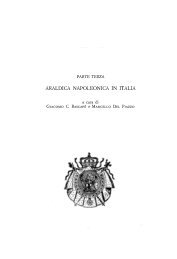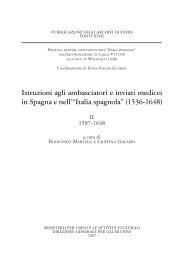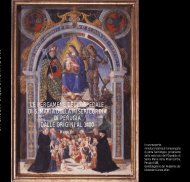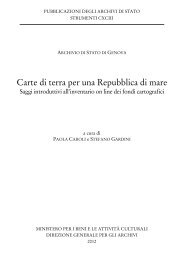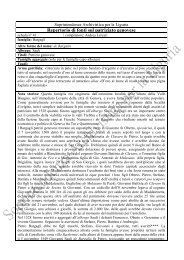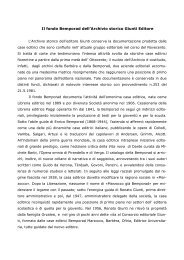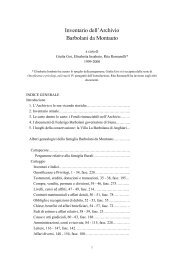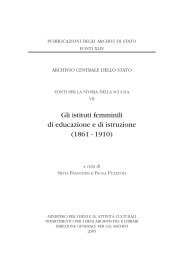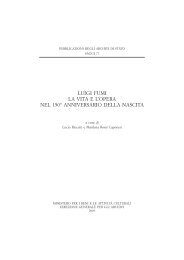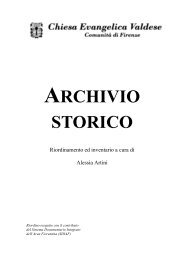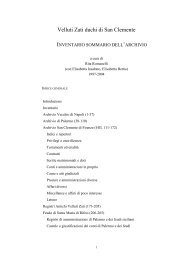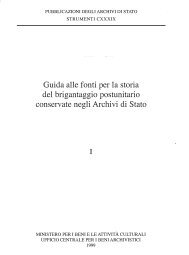esercito e città dall'unità agli anni trenta. tomo i - Sistema ...
esercito e città dall'unità agli anni trenta. tomo i - Sistema ...
esercito e città dall'unità agli anni trenta. tomo i - Sistema ...
You also want an ePaper? Increase the reach of your titles
YUMPU automatically turns print PDFs into web optimized ePapers that Google loves.
490 JOHN A. DAVIS<br />
n or Generai of Tuscany complained to Turin about the disruptive behaviour<br />
of Piedmontese troops in Florence, especially the Carabinieri:<br />
' ... qualche parte di quei Carabinieri erano ragazzi tratti dal civile l'anno<br />
scorso, senza precedenti e senza istruzione militare, ed altri erano viziosi<br />
trascuranti dei loro doveri che marciavano sbandati per la Città associandosi<br />
a compagnevoli Brigate invece di serbare un contegno dignitoso e marziale<br />
ed eseguire il loro servizio ... 15 .<br />
There are many aspects of the army's presence in the leading cities of<br />
the annexed states once the immediate emergiencies of Unification were over<br />
that need to be studied more closely. For example, was conscription imposed<br />
with the same rigour in urban as in rural areas? It would clearly have<br />
been much easier for many sections of the urban petty bourgeoisie an d also<br />
for many workers (shopkeepers, craftsmen etc) to obtain exemptions, and<br />
it would be worth knowing whether urban conscription was skewed to fall<br />
more heavily on the marginai sections of the urban population -<br />
unemployed migrants in particular 16.<br />
In the period of commerciai recession and of major economie readjustments<br />
that followed the extension of the Piedmontese tariff system to<br />
the annexed states, the military garrisons provided an important focus of<br />
urban economie activities, especially in the former capitai cities. In Naples,<br />
for example, contracts for military provisions, materials and uniforms were<br />
one of the few elements of continuity and one of the few safeguards in the<br />
otherwise devastated economie life of the ex-capitai in these years.<br />
The materia! an d physical requirements of the mìlitary garrisons touched<br />
o n the li ves of many different groups of citizens, an d provided tradesmen<br />
and suppliers with a regular livelihood. But although the military garrisons<br />
were an important focus of demand in the economie life on the Italian cities,<br />
i t was a matter of policy that a wide range of servìce industries w ere create d<br />
within the army, and this policy continued long after it had been abandoned<br />
by many other European states where services of this sort were contracted<br />
out. As a result, a relatively large number of Italian soldiers (both conscripts<br />
and long-service men) were were in fact 'soldati-operai', performing fune-<br />
15 ACSR, Min. Int., Gabinetto, B. 4, fascic. 8 (186o).<br />
16 On the comparative leniency of the Italian conscription quotas, and in particular<br />
the wide range of exemptions, see A. CHAPPERON, L 'organico militare fra le due Guerre<br />
Mondiali 1814-1914, Roma 1921, pp. 398-406.<br />
THE ARMY AND PUBLIC ORDER IN ITALIAN CITIES 491<br />
tions from generai maintenance to boot and shoe-making, saddle-making,<br />
carpentry, building etc 17 .<br />
In addition to the 'soldati-operai' that worked in and around the urban<br />
garrisons there were also large numbers of urban workers who were subject<br />
to direct military discipline. This was the case ofthe workers employed<br />
in military and naval arsenals, and a range of other workshops. The killing<br />
of a number of workers at the Neapolitan Pietrarsa arsenal in 1862 when<br />
an attempted strike was repressed by force on the grounds that it constituted<br />
a mutiny 18 was a clamorous but by no means isolated example of the ways<br />
in which many key groups of urban industriai workers were permanently<br />
under military law, while the expansion of the engineering, ship-building,<br />
munitions and armaments industries in the years that followed meant that<br />
their numbers increased. The forms of discipline and regulations that<br />
operated in these military workshops were also used as models and applied<br />
more widely in other state-run eneterprises - notably the state-run Tabacco<br />
Factories - that had no connection with the military 19.<br />
The authority that the military exercised over these sections of the labour<br />
force was an important aspect of the day to day contacts between the army<br />
and urban society in Italy in the late 19th century. It is also worth noting<br />
in this context that it was when the crude politics of repression in the face<br />
of organized labour gave way after 1900 to the more subtle Giolittian tactics<br />
of consensus that the threat of militarization against groups of workers<br />
who were deemed capable of jeopardizing key national interests (eg the<br />
railwaymen in 1904) began to be used more frequently.<br />
The Army and Urban Order<br />
Once the immediate emergencies of Unification had been overcome,<br />
however, it was widely accepted that the professionalization of the army<br />
required clearer distinctions between civil and military policing. That distinction<br />
had first been established by the Pinelli Law (1848), and took institutional<br />
form in Piedmont in 1852 when the office of Questore was established<br />
in ali towns with a population greater than 20,000. Responsability for<br />
polizia amministrativa in each town and district lay with the Questore,<br />
17 Ibid., p. 549.<br />
18 Cf. A. SciRocco, Il Mezzogiorno nella Società italiana, Napoli 1979, p. 70.<br />
19 Cf. L. SPINELLI, 'Disciplina di fabbrica e lavoro femminile: le operaie della Manifattura<br />
dei Tabacchi 1900-1914', Società e Storia 1985, pp. 319-373.<br />
34



